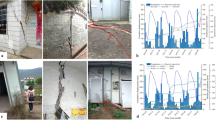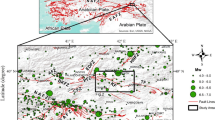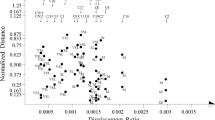Abstract
Slow-moving landslides cause significant economic losses associated with damage to facilities and interruption of human activity in mountainous regions and along river valleys. Physical vulnerability of structures exposed to slow-moving landslides is a required input for informed risk mitigation decision-making. However, the quantification of this vulnerability is still a major challenge. Few studies have been completed on this topic due to the limited historical data of the building damage associated with the comprehensive descriptions of the landslide mechanism. This research presents an experimental approach to investigating the mechanism of damage development and evolution on masonry buildings exposed to ground tension cracks associated with slow-moving landslides. A one-tenth scale model of a masonry building was designed and tested on the newly developed test table. The details of the testing setup are presented in this paper. The scaled model was constructed using sintered clay brick masonry and an unreinforced concrete foundation. An artificial tension crack was opened under the scaled model through the application of loading steps, in the direction parallel to the model foundation. The internal strains and associated forces developed on the scale model walls and foundation were measured by strain gauges. It was observed that the damage ranged from cracking to partial out-of-plane failure of the walls and the foundation. The damage level increased with the propagation of the tension crack on the test table. The final observation results were compared and validated against the field observations of damaged buildings on slow-moving landslides in TGR area in China. The experimental loading device simulated building damage caused by ground horizontal displacements and can bridge the gap in understanding the effects of slow-moving landslides on structures. It provided a new way to analyze the vulnerability of masonry structure under horizontal movement patterns of slow-moving landslides.





















Similar content being viewed by others
Data availability
The data of material strength and the model strain were our original data by test. The data of landslide displacement and building damaged were collected by the field work. And the monitoring data of the ** Landslides was provided by the Geological Environment Monitoring Master Station of Chongqing. The data are not available online. If readers want to have the data, they can request it by e-mail from the authors.
Abbreviations
- TGR:
-
Three gorges reservoir
- DInSAR:
-
Differential interferometric synthetic aperture radar
- InSAR:
-
Interferometry with satellite radars with synthetic aperture
- GNSS:
-
Global navigation satellite system
- UAV:
-
Unmanned aerial vehicle
- \(\upsigma\) :
-
Stress of material (Pa)
- \(\varepsilon\) :
-
Strain of material
- E :
-
Young's modulus (Pa)
- \(v\) :
-
Poisson’s ratio
- \(\uprho\) :
-
Mass density (kg/m3)
- \(l\) :
-
Length (m)
- \(\updelta\) :
-
Linear movement (m)
- \(\uptheta\) :
-
Angular movement (rad)
- A:
-
Area (m2)
- \(P\) :
-
Concentrated load (N)
- M :
-
Moment (N m)
- \(m\) :
-
Mass (kg)
- C:
-
Cement
- S:
-
Sand
- G:
-
Stone
- W:
-
Water
- F:
-
The dimension of the force
- L:
-
The dimension of the length
- T:
-
The tractive force from the loading device
References
Alexander D (1989) Urban landslides. An international review of geographical work in the natural and environmental sciences. Prog Phys Geogr 13:157–191
Ali R, Kuriqi A, Kisi O (2020) Human-environment natural disasters interconnection in China: a review. Climate 8:1–28. https://doi.org/10.3390/cli8040048
Antronico L, Borrelli L, Coscarelli R, Gullà G (2015) Time evolution of landslide damages to buildings: the case study of Lungro (Calabria, southern Italy). Bull Eng Geol Environ 74:47–59. https://doi.org/10.1007/s10064-014-0591-y
Bianchini S, Ciampalini A, Raspini F, Bardi F, Di Traglia F, Moretti S, Casagli N (2015) Multi-temporal evaluation of landslide movements and impacts on buildings in San Fratello (Italy) by means of C-Band and X-Band PSI data. Pure Appl Geophys 172:3043–3065. https://doi.org/10.1007/s00024-014-0839-2
Bothara JK, Dhakal RP, Mander JB (2010) Seismic performance of an unreinforced masonry building: an experimental investigation. Earthq Eng Struct Dyn 39:45–68. https://doi.org/10.1002/eqe.932
Buckingham E (1914) On physically similar systems; Illustrations of the use of dimensional equations. Phys Rev 4:345–376. https://doi.org/10.1103/PhysRev.4.345
Carlà T, Macciotta R, Hendry M, Martin CD, Edwards T, Evans T, Farina P, Intrieri E, Casagli N (2018) Displacement of a landslide retaining wall and application of an enhanced failure forecasting approach. Landslides 15:489–505. https://doi.org/10.1007/s10346-017-0887-7
Cascini L, Fornaro G, Peduto D (2010) Advanced low- and full-resolution DInSAR map generation for slow-moving landslide analysis at different scales. Eng Geol 112:29–42. https://doi.org/10.1016/j.enggeo.2010.01.003
Chen Q, Chen L, Gui L, Yin K, Shrestha DP, Du J, Cao X (2020) Assessment of the physical vulnerability of buildings affected by slow-moving landslides. Nat Hazards Earth Syst Sci 20:2547–2565. https://doi.org/10.5194/nhess-20-2547-2020
Chen L, Cao X, Yin K, Wu Y, Li Y (2016) Physical vulnerability assessment for buildings impacted by a slow moving landslide based on field work and statistical modelling. In: Proceeding of 12th international symposium on landslides, vol 2, Napoli, Italy, 2016, pp 627–634. https://doi.org/10.1201/b21520-70
Chung LL, Reinhorn AM, Soong TT (1988) Experiments on active control of seismic structures. J Eng Mech 114:241–256. https://doi.org/10.1061/(ASCE)0733-9399(1988)114:2(241)
Cruden DM, Varnes DJ (1996) Landslide types and processes. In: Turner AK, Schuster RL (eds) Landslides, investigation and mitigation Special Report 247. Transportation Research Board, National Research Council, vol 3. National Academy Press, Washington, pp 36–75
Deane E, Macciotta R, Hendry MT, Gräpel C, Skirrow R (2020) Leveraging historical aerial photographs and digital photogrammetry techniques for landslide investigation—a practical perspective. Landslides 17:1989–1996. https://doi.org/10.1007/s10346-020-01437-z
Du F, Xu M, ** landslide. J Eng Geol 26:694–702. https://doi.org/10.13544/j.cnki.jeg.2017-175
Du J, Yin K, Glade T, Woldai T, Chai B, **ao L, Wang Y (2020) Probabilistic hazard analysis of impulse waves generated by multiple subaerial landslides and its application to Wu Gorge in Three Gorges Reservoir, China. Eng Geol 276:105773. https://doi.org/10.1016/j.enggeo.2020.105773
Esmaeilabadi R, Abasszadeh Shahri A, Behzadafshar K, Gheirati A, Nosrati Nasrabadi J (2015) Frequency content analysis of the probable earthquake in Kopet Dagh region—Northeast of Iran. Arab J Geosci 8:3833–3844. https://doi.org/10.1007/s12517-014-1446-3
Fell R (2018) Human induced landslides. Landslides and engineered slopes. Experience, theory and practice, pp 171–199
Ferlisi S, Gullà G, Nicodemo G, Peduto D (2019) A multi-scale methodological approach for slow-moving landslide risk mitigation in urban areas, southern Italy. Euro-Mediterr J Environ Integr 4:20. https://doi.org/10.1007/s41207-019-0110-4
Ferlisi S, Marchese A, Peduto D (2021) Quantitative analysis of the risk to road networks exposed to slow-moving landslides: a case study in the Campania region (southern Italy). Landslides 18:303–319. https://doi.org/10.1007/s10346-020-01482-8
Ferlisi S, Peduto D, Gullà G, Nicodemo G, Borrelli L, Fornaro G (2015) The use of DInSAR data for the analysis of building damage induced by slow-moving landslides. In: Lollino G et al. (eds) Engineering geology for society and territory—volume 2: Landslide processes. Springer Nature, Switzerland, pp 1835–1839. https://doi.org/10.1007/978-3-319-09057-3
Galli M, Guzzetti F (2007) Landslide vulnerability criteria: a case study from Umbria, central Italy. Environ Manage 40:649–664. https://doi.org/10.1007/s00267-006-0325-4
Giardina G, Marini A, Hendriks MAN, Rots JG, Rizzardini F, Giuriani E (2012) Experimental analysis of a masonry façade subject to tunnelling-induced settlement. Eng Struct 45:421–434. https://doi.org/10.1016/j.engstruct.2012.06.042
Graziotti F, Tomassetti U, Kallioras S, Penna A, Magenes G (2017) Shaking table test on a full scale URM cavity wall building. Bull Earthq Eng 15:5329–5364. https://doi.org/10.1007/s10518-017-0185-8
Guo Z, Chen L, Yin K, Shrestha DP, Zhang L (2020) Quantitative risk assessment of slow-moving landslides from the viewpoint of decision-making: a case study of the Three Gorges Reservoir in China. Eng Geol 273:105667. https://doi.org/10.1016/j.enggeo.2020.105667
Huntley D, Bobrowsky P, Hendry M, Macciotta R, Elwood D, Sattler K, Best M, Chambers J, Meldrum P (2019) Application of multi-dimensional electrical resistivity tomography datasets to investigate a very slow-moving landslide near Ashcroft, British Columbia, Canada. Landslides 16:1033–1042. https://doi.org/10.1007/s10346-019-01147-1
Jiang H, Li Y, Zhou C, Hong H, Glade T, Yin K (2020) Landslide displacement prediction combining LSTM and SVR algorithms: a case study of shengjibao landslide from the three gorges reservoir area. Appl Sci (Switzerland) 10:1–21. https://doi.org/10.3390/app10217830
Journault J, Macciotta R, Hendry MT, Charbonneau F, Huntley D, Bobrowsky PT (2018) Measuring displacements of the Thompson River valley landslides, south of Ashcroft, BC, Canada, using satellite InSAR. Landslides 15:621–636. https://doi.org/10.1007/s10346-017-0900-1
Kang H, Kim Y (2016) The physical vulnerability of different types of building structure to debris flow events. Nat Hazards 80:1475–1493. https://doi.org/10.1007/s11069-015-2032-z
Kilicoglu C, Cetin M, Aricak B, Sevik H (2020) Site selection by using the multi-criteria technique—a case study of Bafra, Turkey. Environ Monit Assess 192:608. https://doi.org/10.1007/s10661-020-08562-1
Li Y, Utili S, Milledge D, Chen L, Yin K (2021) Chasing a complete understanding of the failure mechanisms and potential hazards of the slow moving Liangshui**g landslide. Eng Geol 281:105977. https://doi.org/10.1016/j.enggeo.2020.105977
Liang X, Gui L, Wang W, Du J, Ma F, Yin K (2021) Characterizing the development pattern of a colluvial landslide based on long-term monitoring in the three gorges reservoir. Remote Sens 13:1–23. https://doi.org/10.3390/rs13020224
Liu S, Segoni S, Raspini F, Yin K, Zhou C, Zhang Y, Casagli N (2020) Satellite InSAR as a new tool for the verification of landslide engineering remedial works at the Regional Scale: a case study in the three gorges Resevoir area, China. Appl Sci 10:6435. https://doi.org/10.3390/app10186435
Lowry B, Gomez F, Zhou W, Mooney MA, Held B, Grasmick J (2013) High resolution displacement monitoring of a slow velocity landslide using ground based radar interferometry. Eng Geol 166:160–169. https://doi.org/10.1016/j.enggeo.2013.07.007
Macciotta R, Hendry M, Martin CD (2016) Develo** an early warning system for a very slow landslide based on displacement monitoring. Nat Hazards 81:887–907. https://doi.org/10.1007/s11069-015-2110-2
Macciotta R, Carlà T, Hendry M, Evans T, Edwards T, Farina P, Casagli N (2017) The 10-Mile slide and response of a retaining wall to its continuous deformation Renato, advancing culture of living with landslides. Springer International Publishing, Cham. https://doi.org/10.1007/978-3-319-53487-9
Mansour MF, Morgenstern NR, Martin CD (2011) Expected damage from displacement of slow-moving slides. Landslides 8:117–131. https://doi.org/10.1007/s10346-010-0227-7
Mansour MF (2009) Characteristic behaviour of slow-moving slides. Ph.D. Thesis, University of Alberta
Mavrouli O, Corominas J, Ibarbia I, Alonso N, Jugo I, Ruiz J, Luzuriaga S, Navarro JA (2019) Integrated risk assessment due to slope instabilities in the roadway network of Gipuzkoa, Basque Country. Nat Hazards Earth Syst Sci 19:399–419. https://doi.org/10.5194/nhess-19-399-2019
Ministry of Housing and Urban–Rural Development of PRC (2011) Code for design of masonry structures. China Architecture and Building Press, Bei**g
Ministry of Housing and Urban–Rural Development of the PRC (2009) Standard for test method of performance on building mortar. China Architecture and Building Press, Bei**g
Ministry of Housing and Urban–Rural Development of the PRC (2010) Specification for mix proportion design of masonry mortar. China Architecture and Building Press, Bei**g
Ministry of Housing and Urban–Rural Development of the PRC (2019) Standard for test methods of concrete physical and mechanical properties. China Architecture and Building Press, Bei**g
Nicodemo G, Ferlisi S, Peduto D, Aceto L, Gullà G (2020) Damage to masonry buildings interacting with slow-moving landslides: a numerical analysis. In: Calvetti F, Cotecchia F, Galli A, Jommi C (eds) Geotechnical research for land protection and development CNRIG 2019. Lecture Notes in Civil Engineering, vol 40. Springer, Cham. https://doi.org/10.1007/978-3-030-21359-6_6
Paolucci R, Shirato M, Yilmaz MT (2008) Seismic behaviour of shallow foundations: Shaking table experimentsvs numerical modelling. Earthq Eng Struct Dyn 37:577–595. https://doi.org/10.1002/eqe.773
Peduto D, Ferlisi S, Nicodemo G, Reale D, Pisciotta G, Gullà G (2017) Empirical fragility and vulnerability curves for buildings exposed to slow-moving landslides at medium and large scales. Landslides 14:1993–2007. https://doi.org/10.1007/s10346-017-0826-7
Rodriguez J, Deane E, Hendry MT, Macciotta R, Evans T, Gräpel C, Skirrow R (2021) Practical evaluation of single-frequency dGNSS for monitoring slow-moving landslides. Landslides 18:3671–3684. https://doi.org/10.1007/s10346-021-01737-y
Sangirardi M, Amorosi A, de Felice G (2020) A coupled structural and geotechnical assessment of the effects of a landslide on an ancient monastery in Central Italy. Eng Struct 225:111249. https://doi.org/10.1016/j.engstruct.2020.111249
Shahri AA, Spross J, Johansson F, Larsson S (2019) Landslide susceptibility hazard map in southwest Sweden using artificial neural network. Catena 183:104225. https://doi.org/10.1016/j.catena.2019.104225
Shi Y(2011) Study on the base damage mechanics of bridge and building under ground fissure with large-scale tests. Ph.D. Thesis, Chang’an University.
Singh A, Kanungo DP, Pal S (2019) Physical vulnerability assessment of buildings exposed to landslides in India. Nat Hazards 96:753–790. https://doi.org/10.1007/s11069-018-03568-y
Somma F, Millen M, Bilotta E, Flora A, Viana Da Fonseca A (2020) Vulnerability assessment of RC buildings to lateral spreading. Bull Earthq Eng 18:3629–3657. https://doi.org/10.1007/s10518-020-00847-7
Son M, Cording EJ (2005) Estimation of building damage due to excavation-induced ground movements. J Geotech Geoenviron Eng 131:162–177. https://doi.org/10.1061/(asce)1090-0241(2005)131:2(162)
Sun Q, Zhang L, Ding X, Hu J, Liang H (2015) Investigation of slow-moving landslides from ALOS/PALSAR images with TCPInSAR: a case study of Oso, USA. Remote Sens 7:72–88. https://doi.org/10.3390/rs70100072
Uzielli M, Catani F, Tofani V, Casagli N (2015) Risk analysis for the Ancona landslide—II: estimation of risk to buildings. Landslides 12:83–100. https://doi.org/10.1007/s10346-014-0477-x
Woods A, Hendry MT, Macciotta R, Stewart T, Marsh J (2020) GB-InSAR monitoring of vegetated and snow-covered slopes in remote mountainous environments. Landslides 17:1713–1726. https://doi.org/10.1007/s10346-020-01408-4
Woods A, Macciotta R, Hendry MT, Stewart T, Marsh J (2021) Updated understanding of the deformation characteristics of the Checkerboard Creek rock slope through GB-InSAR monitoring. Eng Geol 281:105974. https://doi.org/10.1016/j.enggeo.2020.105974
Wu Y, Liu DS, Li MJ (2011) landslide model experiment for energy dissipation law in sliding and impact processes. Chin J Rock Mech Eng 30:693–701
Xu Q, Tang MG, Xu KX, Huang XB (2008) Research on space-time evolution laws and early warning-prediction of landslides. Chin J Rock Mech Eng 27:1104–1112
Yang B, Yin K, Lacasse S, Liu Z (2019) Time series analysis and long short-term memory neural network to predict landslide displacement. Landslides 16:677–694. https://doi.org/10.1007/s10346-018-01127-x
Yu B, Yi W, Zhao H (2018) Experimental study on the maximum impact force by rock fall. Landslides 15:233–242. https://doi.org/10.1007/s10346-017-0876-x
Zhang J, Guo ZX, Wang D, Qian H (2016a) The quantitative estimation of the vulnerability of brick and concrete wall impacted by an experimental boulder. Nat Hazards Earth Syst Sci 16:299–309. https://doi.org/10.5194/nhess-16-299-2016
Zhang J, Zhai X, Liu B, Jiang W (2016) Analysis and processing of strain measurement data of solid rocket motor. Meas Control Technol 35:36–39. https://doi.org/10.19708/j.ckjs.2016.09.009
Zhou C, Cao Y, Yin K, Wang Y, Shi X, Catani F, Ahmed B (2020) Landslide characterization applying sentinel-1 images and InSAR technique: The Muyubao landslide in the three Gorges Reservoir area. China Remote Sens 12:3385. https://doi.org/10.3390/rs12203385
Acknowledgements
We thank **nghua Zhu, Juting Zhang, Wenfang Zhang, and other laboratory colleagues for assisting to complete the physical model test. We want to thank the editors and the two anonymous reviewers for their constructive comments, which helped us to improve the quality of the article.
Funding
This research is supported by two projects “Studies on spatial–temporal differences in large accumulation landslide deformation and its vulnerability model for buildings in the Three Gorges reservoir” (Grant No. 41877525) and “Study on the dynamic response of the quantitative vulnerability of buildings in different evolution stages of landslides” (Grant No. 41601563), both of which are financed by the National Natural Science Foundation of China. The first author (Grant No. 202106410017) is supported by China Scholarship Council (CSC) as a visiting Ph.D. student at the University of Alberta, Canada, under Dr. Renato Macciotta’s supervision.
Author information
Authors and Affiliations
Contributions
All authors contributed to the study conception and design. LC and LG designed the physical model test plan. The test material preparation, data collection, and field work were performed by QC, YZ and YL. And QC carried out the analysis of the test data. KY and LC supervised the research. The first draft of the manuscript was written by QC, and all authors commented on previous versions of the manuscript. RM and LC revised and improved this manuscript. All authors read and approved the final manuscript.
Corresponding author
Ethics declarations
Conflict of interest
The authors declare that they have no known competing financial interests or personal relationships that could have appeared to influence the work reported in this paper.
Additional information
Publisher's Note
Springer Nature remains neutral with regard to jurisdictional claims in published maps and institutional affiliations.
Rights and permissions
Springer Nature or its licensor (e.g. a society or other partner) holds exclusive rights to this article under a publishing agreement with the author(s) or other rightsholder(s); author self-archiving of the accepted manuscript version of this article is solely governed by the terms of such publishing agreement and applicable law.
About this article
Cite this article
Chen, Q., Chen, L., Macciotta, R. et al. Experimental investigation of masonry building damage caused by surface tension cracks on slow-moving landslides. Nat Hazards 119, 1193–1221 (2023). https://doi.org/10.1007/s11069-023-06141-4
Received:
Accepted:
Published:
Issue Date:
DOI: https://doi.org/10.1007/s11069-023-06141-4




